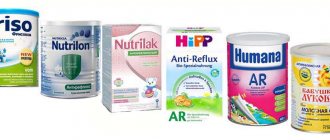I have already talked about dry mixtures and their composition. From this material it becomes clear that palm oil is being added less and less to dry infant formula, but is this really a good thing? After all, the main task of an adapted dry formula is to be as close as possible to breast milk. And it contains palmitoleic and palmitic acids, which are found in large quantities in palm oil.
Palmitic acids are named after the oil palm from which they were isolated in 1840. Palm acids are also found in butter, dairy products, coconut oil (this is what is now added to mixtures instead of palm oil), soybean, sunflower - but not in such quantities as in palm oil. Palm oil is needed in the mixture because of the acids, but it is replaced with coconut oil to fill this gap, or diluted with various derivatives of palmitic acid (such as SImilac). And now the most important thing is why palm oil is being added less and less to dry mixtures.
Why is palm oil added to baby formula?
In the production of infant formula, whey is used to bring the content of whey proteins and casein closer to their content in breast milk. But, in the process of obtaining whey, the content of milk fats decreases. In order to compensate for the lack of fat. And to bring their composition closer to the composition of human milk fats, vegetable oils are added to the mixture, incl. Palm.
Palm oil in infant formula is a source of saturated fatty acids and fat-soluble vitamins. Saturated fatty acids are needed by the child's body as a source of energy. And also for the construction of hormones and cell membranes. In case of a lack of these acids, the human body can synthesize them from carbohydrates. But this requires additional energy expenditure.
How to choose a formula for a newborn
The mixture should be well absorbed by the child's body and not cause allergic reactions.
When choosing products you need:
- carefully read the composition of the product and the information located on the packaging;
- choose a trusted manufacturer;
- look at the shelf life of products;
- take into account the age category;
- take into account the quality of the product packaging;
- take into account what problems the mixture was created to solve.
When choosing formula for newborns, which is better, professional requirements and recommendations are taken into account:
- Adapted products are suitable for babies from the first days of life. Its composition is most similar to mother's milk. These products are more easily absorbed and digested by the child’s body.
- When purchasing formula, you should consider the age of the child. To start artificial feeding, a first-stage product is selected. You can add a mixture of the second category to the diet after 6 months.
- If negative reactions occur on the part of the child’s body, for example, with a stable digestive disorder, they switch to medicinal products. At the same time, not all meals are replaced: a new product is introduced into the child’s diet gradually, starting with 10 ml per day. Fermented milk mixtures can replace half of a baby’s diet. They will avoid increased gas formation.
- When purchasing, you need to carefully study the label. You should purchase a mixture that does not contain palm and rapeseed oil. Experts recommend buying products enriched with a vitamin-mineral complex.
- You should avoid using mixtures that are about to expire. You need to choose a fresh product.
- When shopping, you should go to stores that provide optimal conditions for storing goods.
- Preference should be given to mixtures that contain linoleic acid, carnitine, taurine,. These components participate in the metabolic processes of proteins, fats, carbohydrates, and contribute to the generation of tissues, i.e. growth and formation of internal organs.
- It is necessary to take into account the child’s reaction to the administered product. If symptoms of an allergic reaction appear, or problems with the digestive system are discovered, then you need to consult a pediatrician.
The harm of palm oil
The press discusses the dangers of palm oil for people in general, and specifically for infants.
Harm for everyone
The harm for everyone is that palm oil, like animal fats (butter, lard, etc.), contains a large amount of saturated fatty acids and also contains cholesterol. Regular excess consumption of such foods increases the risk of cardiovascular disease and excess weight gain.
At the same time, children, including infants, need cholesterol and fatty acids in certain quantities as a source of energy. And also as a material for the construction of hormones and cell membranes .
Therefore, from this point of view, consumption of palm oil in an age-appropriate amount will benefit him and not harm him.
Harm to infants
The harm to infants is that palm oil reduces the absorption of calcium from infant formula . A number of studies have been conducted showing that calcium in the body of children who were fed formulas with palm oil is absorbed 15-20% worse than in children who were fed formulas without palm oil.
This is due to the unfavorable lateral position of palmitic acid in the fat molecule. In this position, it is easily cleaved off under the influence of the lipase enzyme. Free palmitic acid in the child’s intestines combines with calcium, forming insoluble complexes that are not absorbed and are excreted from the body. Thus, in mixtures containing palm oil, the absorption of not only calcium but also fat is reduced . The presence of such calcium salts in the intestines adversely affects the character of stool. And contributes to the development of constipation .
Such effects of palm oil are undesirable for a child.
Rating of formulas 2021 for children from 6 months
All of the mixtures listed above are highly versatile, suitable not only for six-month-old, but also for one-year-old babies. At the same time, if you want to get a more age-specific product for children over 6 months, then you should take a closer look at any of the five positions in the rating below, which was also based on reviews from real customers from the popular Ozon platform and the Otzovik website.
Similac Gold 2
The products of the famous Danish manufacturer have become a real bestseller, chosen by many mothers due to its unique composition, the only one on the Russian market containing breast milk oligosaccharides.
In addition, the adapted mixture does not contain GMOs and palm oil, so it can be safely given to babies without fear of any consequences. A pleasant bonus for buyers will be the long shelf life (2 years) and the price tag (88 rubles per 100 g of mixture).
excellent composition and digestibility, even if the child had allergies before Similac;
a fattier composition after the update, thanks to which it was possible to increase the level of saturation of the mixture;
good price compared to similar products.
lumps often form during dilution;
repeated complaints about the presence of heterogeneous lumps, which is basically unacceptable;
lack of a lock for the measuring spoon, which is not very convenient to use;
The mixture is often not found on the open market, which is why you have to order it and receive crumpled and dirty packaging (the powder itself does not suffer due to the tightness of the container).
Nestle NAN 2 OptiPro
Another high-quality mixture, adapted for the second stage of feeding, which is sold at a relatively affordable price - 106 rubles. per 100 g. Rich in healthy animal proteins, fats, nutrients and bifidobacteria, it promotes the proper development of brain and visual function, as well as the formation of the immune system, while simultaneously reducing the load on other important systems and organs, which is also very important during this period of a baby’s life.
good, convenient and quick to prepare mixture;
high saturation and economical consumption;
absence of harmful components in the composition;
There is no long adjustment and no colic when switching to a new composition.
limited sales, ordering possible via online platforms.
Friso Gold Lock Nutri
The mixture produced in the Netherlands is ideal for both mixed and artificial feeding, being produced using LockNutri's unique technology, which involves the most gentle processing of raw milk. Thanks to this, the product retains most of its valuable qualities, providing the baby with everything necessary at such an important stage of growing up.
gentle processing of the mixture using special technology;
farm milk included;
high nutritional value and satiety;
price – 100 g costs 75 rubles;
convenient and airtight jar.
limited access - often the mixture cannot be found in pharmacies, which is why you have to spend time searching for it, ordering it and waiting for delivery.
Valio Baby 2
An ideal mixture for healthy children, produced in Finland, with a 1.5-year shelf life and a reasonable price of 82 rubles. for every 100 g. There is also no gluten, palm oil, starch, GMOs or other unacceptable additives. The powder dissolves well, does not spoil for a long time in open packaging and does not provoke diathesis rashes, despite the cow protein in the composition.
good quality and reasonable price;
absence of lumps and foam during dilution;
safety;
convenient measuring spoon.
inconvenient and impractical cardboard packaging (the reverse side of the affordable price tag);
limited availability in regular pharmacies.
Why do they continue to add palm oil to baby formulas?
Palmitic acid is found in most vegetable and animal fats. Palm oil contains approximately 39-47%, lard - 30%, butter 25%, soybean oil 6.5%. In all of these foods, palmitic acid is found primarily in the unfavorable side or alpha position. And only in human milk is palmitic acid located in the central or beta position. In this position, lipase does not act on it and calcium salts are not formed.
It is impossible to make a product absolutely identical in composition to human milk . Children who were and are formula-fed develop absolutely normally with palm oil. Therefore, palm oil in infant formula is permitted by all nutrition institutes.
But manufacturers of infant formula are constantly working to improve their composition..
When is artificial nutrition needed?
Artificial nutrition is recommended to be introduced in some situations when continuation of natural feeding is impossible:
- Treatment of infectious diseases in the mother of a newborn, during which the baby should not be fed breast milk.
- The amount of milk is not produced in sufficient quantities to meet the baby's needs.
- Lack of milk in the mammary glands. This factor is determined when the newborn is weighed at a doctor's appointment.
- Difficult childbirth or the appearance of complications after childbirth in a woman.
- Taking medications that are incompatible with breastfeeding.
- The mother cannot be with the child all the time.
- Young mother is against breastfeeding.
Palm oil free blends
There are blends without palm oil. Which are most actively advertised as mixtures without palm oil: Nanny and Similak . But these mixtures have their drawbacks. They are not whey, but casein. These mixtures are less close to human milk in terms of protein composition . What is best for the child is up to you, dear parents, to choose.
Since 2015, the Nestozhen mixture does not contain palm oil, but it does contain coconut oil. Nestozhen refers to whey mixtures, which means it is close in composition to human milk.
As of 2021, Nan blend is made without palm oil, but contains rapeseed and coconut oil. Nan mixture also refers to whey mixtures.
Where can I find mixtures without it?
Are there mixtures without it and what kind? to find baby food, including formula, that does not contain palm oil - study the composition. Conscientious manufacturers always indicate all incoming components in full and in Russian.
Buy food from specialized children's goods stores or large retail chains. There is less chance of buying a fake .
Read more about what products contain palm oil and how it can harm you here.
Nowadays, it has become almost impossible to find at least one product on supermarket shelves that does not contain a single so-called food additive. Read our materials about which “E-ki” are allowed and prohibited for use in food production, and whether E407, E322, sulfur dioxide E220, E171, E339, E331, E551, E500 are dangerous or not for the human body.
Beta palmitate
Finally, the latest achievement in this area.
Some manufacturers have learned to artificially change the position of palmitic acid in palm olein . The result is structured palm oil or beta palmitate . Palmitic acid occupies a central position in it, just as in human milk. From such mixtures, calcium and fats are absorbed much better. And they do not cause constipation.
If you want to buy such a mixture, look for beta palmitate . This group includes mixtures Nutrilon, Heinz and Cabrita .
Causes
Why, why or for what purpose is it added? The answer to these questions lies in the properties of palm oil. Oleic acid is an oil component that is resistant to oxidation . It significantly increases the shelf life of formula for baby food and dairy products.
Moreover, if the oil is not indicated in the composition, or is disguised as “fats of vegetable origin”, etc., then we will not be able to determine its taste in any way. Especially in dairy products. It has a pleasant creamy taste .
Similak
Similak infant formula is made from natural cow's milk. List of substances included in the composition:
Similac contains a complex of vitamins A, D, E, K, C, B. All of them are contained in quantities necessary for the development of a healthy baby. Similac also contains arachidonic, linoleic, linolenic acids, carbohydrates, lactose and protein. These substances are necessary for the growth and development of the child. To prepare artificial milk, you can only use boiled water with a temperature of no more than 50 degrees. Otherwise, all beneficial substances and microorganisms will die. The finished mixture can only be used for 60 minutes; after the expiration date, it must be poured out and the bottle should be rinsed thoroughly.










